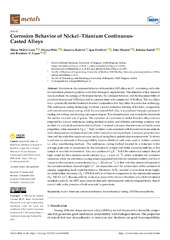Приказ основних података о документу
Corrosion Behavior of Nickel–Titanium Continuous-Casted Alloys
| dc.creator | Miličić Lazić, Minja | |
| dc.creator | Mitić, Dijana | |
| dc.creator | Radović, Katarina | |
| dc.creator | Đorđević, Igor | |
| dc.creator | Majerič, Peter | |
| dc.creator | Rudolf, Rebeka | |
| dc.creator | Grgur, Branimir N. | |
| dc.date.accessioned | 2024-02-09T10:54:38Z | |
| dc.date.available | 2024-02-09T10:54:38Z | |
| dc.date.issued | 2024 | |
| dc.identifier.issn | 2075-4701 | |
| dc.identifier.uri | http://TechnoRep.tmf.bg.ac.rs/handle/123456789/7189 | |
| dc.description.abstract | Variations in the corrosion behavior of biomedical NiTi alloys in Cl− containing and acidic environments present a problem with their biological implantation. The objective of this research was to evaluate the synergy of the microstructure, the corrosion behavior, and the biocompatibility of novel continuous-cast NiTi alloys and to compare them with commercial NiTi alloys. The two alloys have a practically identical nominal chemical composition, but they differ in production technology. The continuous casting technology involved vacuum induction melting of the basic components and vertical continuous casting, while the commercial NiTi alloy was produced through a process of casting, hot rolling, and forming into square shapes. The microstructure was revealed to determine the surface area and size of grains. The corrosion of a commercial nickel–titanium alloy and one prepared by a novel continuous casting method in acidic and chloride-containing solutions was studied via analytical and electrochemical tests. Localized corrosion characteristics related to oxide properties, when exposed to 9 g L−1 NaCl solution, were examined with focused ion beam analysis and subsequent microchemical analysis of the formed corrosive products. Corrosion potential over time and the oxide film resistance were analyzed using linear polarization measurements. To obtain a preliminary estimate of biocompatibility, human fibroblast cells were used in indirect contact, i.e., alloy conditioning medium. The continuous casting method resulted in a reduction in the average grain size in comparison to the commercial sample and better corrosion stability of the sample in an acidic environment. Also, in a solution of 9 g L−1 NaCl the commercial sample showed high values for the corrosion current density (jcorr = 6 μA cm−2), which indicated low corrosion resistance, while the continuous casting sample possessed much better corrosion stability and lower values for the corrosion current density (jcorr = 0.2 μA cm−2). In line with that, elemental analysis of the corroded surfaces showed higher Cl− ion deposition over the surface layer of the commercial sample, suggesting local oxide breakdown. Moreover, NiTicc reached a value three times higher for polarization resistance (Rp = 270 kΩ cm2) over time in comparison to the commercial sample (Rp~100 kΩ cm2). Biocompatibility evaluation showed that human fibroblast cells exhibited altered metabolic activity. An MTT assay showed that cells’ mitochondrial activity dropped below that of control cells in the presence of both materials’ supernatants. | |
| dc.publisher | MDPI | en |
| dc.relation | International Eureka project GOLD-GERE!17091 | |
| dc.rights | openAccess | |
| dc.rights.uri | https://creativecommons.org/licenses/by/4.0/ | |
| dc.source | Metals | en |
| dc.subject | corrosion behavior | |
| dc.subject | electrochemical testing | |
| dc.subject | nickel–titanium | |
| dc.subject | NiTi biocompatibility | |
| dc.title | Corrosion Behavior of Nickel–Titanium Continuous-Casted Alloys | en |
| dc.type | article | en |
| dc.rights.license | BY | |
| dc.citation.issue | 1 | |
| dc.citation.spage | 88 | |
| dc.citation.volume | 14 | |
| dc.identifier.doi | 10.3390/met14010088 | |
| dc.identifier.fulltext | http://TechnoRep.tmf.bg.ac.rs/bitstream/id/19849/Corrosion_Behavior_of_Nickel_pub_2024.pdf | |
| dc.identifier.scopus | 2-s2.0-85183420568 | |
| dc.type.version | publishedVersion |

